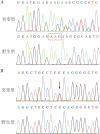[The preliminary research in paroxysmal nocturnal hemoglobinuria with thrombosis]
- PMID: 27093996
- PMCID: PMC7343087
- DOI: 10.3760/cma.j.issn.0253-2727.2016.04.014
[The preliminary research in paroxysmal nocturnal hemoglobinuria with thrombosis]
Abstract
Objective: To explore the high risk factors of thrombosis in paroxysmal nocturnal hemoglobinuria (PNH). It has been reported that in Chinese patients with venous thrombosis, the mutation frequency in PROC c.574_576 del (rs199469469), PROC c.565C>T (rs146922325) and THBD c.-151G>T (rs1698852) was higher than that of normal controls, indicating its importance in thrombophilia pathogenesis.
Methods: 142 patients with PNH diagnosed between 2009 and 2015 were enrolled in the study. Clinical data were analyzed and thrombophilia risk factors, such as the level of protein C, protein S, antithrombin III, APC resistance, blood fat, phospholipid antibody, were evaluated. Samples from patients and 100 normal controls were detected for the mutations of PROC c.574_576 del (rs199469469), PROC c.565C>T (rs146922325) and THBD c.-151G>T (rs1698852) by Sanger sequence.
Results: Of the 142 PNH patients, 21 (14.8%) patients had at least 1 episode of thrombotic event. Only 2 patients had arterial thrombosis and 19 patients had venous thrombosis. The median age of patients with thrombosis was 35 years old, similar to those without episode (40 years old, P=0.687). The ratios of males and females were 1.33 in thrombosis group and 1.57 in non-thrombosis group (P=0.728) , respectively. Patients with thrombosis had the same disease pattern compared with those without episode. Although there was no difference in the level of hemoglobin, WBC and PLT count, and LDH level between patients with thrombosis and those without episode, patients with thrombosis showed higher RBC, higher percentage of CD59(-) granulocytes and RBC, and Flaer(-) granulocytes compared with those without episode. The routine thrombophilia screening tests did not show any difference either between PNH patients and normal controls, or between patients with or without thrombosis. There were two mutations in rs199469469 and rs16984852 sites in patients with PNH, but the mutated patients did not have any thrombosis. Mutation rs146922325 was found in PNH patients. The mutation rate was similar between PNH patients and normal controls, thrombotic PNH and non-thrombotic PNH (P>0.05).
Conclusions: Compared with non-thrombotic patients, PNH thrombotic patients have bigger PNH clone and higher RBC count. There are no differences among the routine thrombophilia factors and the three known venous eligible genes either between PNH patients and normal controls or between thrombotic and non-thrombotic PNH patients.
目的: 探讨阵发性睡眠性血红蛋白尿症(PNH)患者易发血栓的可能因素。
方法: 回顾性分析142例PNH患者的临床资料,对3个已知血栓相关基因位点[PROC c.574_576del(rs199469469)、PROC c.565C>T(rs146922325)和THBD c.-151G>T(rs1698852)]采用Sanger法进行DNA序列检测,以性别、年龄相匹配的100名健康志愿者为正常对照。
结果: 142例患者中,合并血栓者21例(14.8%),其中2例为动脉血栓,19例为静脉血栓,血栓组患者的中位年龄为35(20~67)岁,与非血栓组[40(7~79)岁]比较差异无统计学意义(P=0.687);两组患者的男女比例、PNH临床分类、HGB、WBC、PLT、LDH水平差异均无统计学意义(P值均>0.05)。血栓组RBC、粒细胞CD59−、红细胞CD59−及嗜水气单胞菌溶素变异体阴性细胞(Flear−)百分率均高于非血栓组(P值分别为0.015、0.005、0.004和0.026)。PNH患者组与正常对照组、PNH血栓组与非血栓组之间蛋白C、蛋白S、抗凝血酶Ⅲ、活化蛋白C抵抗、血脂、狼疮抗凝物等常见易栓因素差异均无统计学意义(P值均>0.05)。PNH患者中,rs199469469位点突变1例(0.704%)、rs16984852位点突变2例(1.408%)、无一例发生rs146922325位点突变,所有突变者均无血栓形成;正常对照组3个位点突变率分别为2.424%、0.873%和0.974%。PNH患者组与正常对照组、PNH血栓组与非血栓组之间各位点突变率差异均无统计学意义(P值均>0.05)。
结论: RBC与PNH克隆大小是PNH患者发生血栓的独立危险因素。PNH患者与正常人、PHN合并血栓患者与未合并血栓患者相比,常见遗传性和后天获得性易栓因素、常见的静脉血栓3个易感基因的突变率差异均无统计学意义。
Figures
Similar articles
-
Paroxysmal Nocturnal Hemoglobinuria is rare cause for thrombosis of the intra-abdominal veins in the ethnic Indian population - results from FLAER-based flowcytometry screening.Eur J Haematol. 2014;92(5):435-43. doi: 10.1111/ejh.12265. Epub 2014 Feb 12. Eur J Haematol. 2014. PMID: 24400962
-
Screening for paroxysmal nocturnal hemoglobinuria (PNH) in patients presenting with cerebral sinovenous thrombosis (CSVT): Results of a FLAER based flowcytometry study in Indian patients.J Thromb Thrombolysis. 2020 May;49(4):584-590. doi: 10.1007/s11239-019-01982-y. J Thromb Thrombolysis. 2020. PMID: 31701360
-
Aplastic anemia and paroxysmal nocturnal hemoglobinuria: search for a pathogenetic link.Blood. 1995 Mar 1;85(5):1354-63. Blood. 1995. PMID: 7858265
-
Recent insights into the pathophysiology of paroxysmal nocturnal hemoglobinuria.Med Sci Monit. 2003 Jul;9(7):RA161-72. Med Sci Monit. 2003. PMID: 12883466 Review.
-
Relationship of paroxysmal nocturnal hemoglobinuria (PNH) granulocyte clone size to disease burden and risk of major vascular events in untreated patients: results from the International PNH Registry.Ann Hematol. 2023 Jul;102(7):1637-1644. doi: 10.1007/s00277-023-05269-4. Epub 2023 May 18. Ann Hematol. 2023. PMID: 37199789 Free PMC article. Review.
Cited by
-
Analysis of clinical characteristics of 92 patients with paroxysmal nocturnal hemoglobinuria: A single institution experience in China.J Clin Lab Anal. 2020 Jan;34(1):e23008. doi: 10.1002/jcla.23008. Epub 2019 Sep 10. J Clin Lab Anal. 2020. PMID: 31502726 Free PMC article.
-
[Expert consensus on clonal screening and monitoring of complement inhibitor therapy in paroxysmal nocturnal hemoglobinuria (2024)].Zhonghua Xue Ye Xue Za Zhi. 2024 Feb 14;45(2):109-114. doi: 10.3760/cma.j.cn121090-20230927-00145. Zhonghua Xue Ye Xue Za Zhi. 2024. PMID: 38604785 Free PMC article. Chinese.
References
-
- Socié G, Mary JY, de Gramont A, et al. Paroxysmal nocturnal haemoglobinuria: long-term follow-up and prognostic factors. French Society of Haematology[J] Lancet. 1996;348(9027):573–577. - PubMed
MeSH terms
Substances
LinkOut - more resources
Full Text Sources
Medical
Miscellaneous


